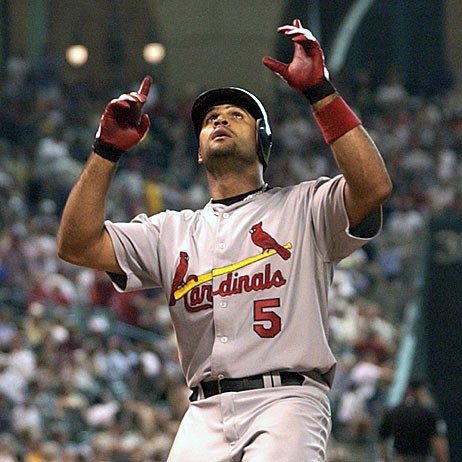Albert Pujols is not a former St. Louis Cardinal. It just feels that way.
With the expiration last Wednesday of a deadline for contract negotiations imposed by Pujols and his agent, Dan Lozano, baseball’s best current player appears to be headed for free agency after the 2011 season. If you believe the various leaks from sources supposedly in touch with the talks, the sticking point appears to be a contract that measures ten years in length (Pujols’ preference) or one that, while making Pujols the game’s richest player in terms of annual salary, would expire in closer to seven years.

Before sweaty palms and shortness of breath overtake Cardinal fans coast to coast, some perspective is in order. To begin with, consider what Pujols has achieved over his decade in a St. Louis uniform: a world championship, two National League pennants, three MVP trophies, nine All-Star Games, two Gold Gloves, a batting title, and two home run crowns. In 2010, Pujols became the first player in baseball history to bat .300 with 30 homers and 100 RBIs for ten consecutive seasons. Regardless of how the current contract saga unfolds, it would be hard to imagine the Pujols plaque at the Baseball Hall of Fame featuring anything besides a Cardinal cap. So in some respects, Cardinal fans need to pause and appreciate what they’ve been lucky enough to witness already. If he never plays another game for St. Louis, Pujols could make a claim as the second best player in franchise history, behind only Stan Musial.
Now, should Pujols decide the Cardinals aren’t offering enough (in cash or number of years), his departure would permanently separate his eventual legacy from those of Musial, Bob Gibson, Lou Brock, Red Schoendienst, and Ozzie Smith, iconic Cardinals who made lengthy stays — well beyond 10 years for each of them — a part of the very fabric that binds the National League’s most successful franchise to its vast region of followers. The questions (however premature) would follow: Do the Cardinals retire Pujols’ number? Does Pujols get a statue alongside other Cardinal legends adjacent to Busch Stadium? How might the second half of Pujols’ career in another uniform (a Cubs uniform?!) soil the first half?
Here’s a good rule for diplomacy, business, and especially the business of sports: Public deadlines are never healthy. When the Pujols camp announced there would be no contract negotiations beyond the player’s arrival for spring training, the Cardinals were cornered. Despite having Pujols under contract through the upcoming season, owner Bill DeWitt essentially had seven months of negotiating strength taken away. If the Pujols camp holds to its announced deadline, the other 29 major-league teams can begin budget plans for a Pujols pitch before February turns to March. You’ve heard of “home team discounts” in free-agent talks? This amounts to a home-team penalty. The Cardinals — guilty of not signing Pujols a full season in advance of his contract’s expiration — had their bargaining stool kicked out from under them.
On the subject of discounts, the argument could be made that the Cardinals have had a profound discount on Pujols, even as they’ve paid him $16 million a year under his current deal. But that figure is less than the Phillies are paying Ryan Howard, less than the Washington Nationals are now paying Jayson Werth(!), and much less than the Yankees have been paying the gold standard for modern baseball contracts, Alex Rodriguez. So for Pujols to stand up and ask to be paid as the game’s finest player should be is hardly egregious. In this particular case, though, involving these particular parties, it’s a bit short-sighted. Because Pujols and the St. Louis Cardinals are a perfect match.
Pujols and his wife have family in nearby Kansas City (the Royals are unlikely suitors in the $30 million per year range). Hardly chummy with TV cameras and microphones, Pujols displays his greatness in a market that somehow still allows him privacy, a life away from Busch Stadium. Would he be as happy — and without “distractions” — in Chicago, New York, or Los Angeles? Consider this: if and when the great Pujols starts slipping, would his decline be accepted more in the Big Apple, Hollywood, or St. Louis? Perhaps Pujols will still break records at age 41. But the likelihood is he won’t. If he’s a Cardinal 10 years from now, the man will draw standing ovations for pinch-running. Will that scenario require $30 million per year for an eighth, ninth, and tenth year? We should know by next Christmas.
In the meantime, the joys of spring training are upon us. Pujols will crush baseballs in Florida as he prepares for a season unlike any other of his distinguished career. Let’s hope it’s a season remembered for the numbers on the back of his baseball card, and not those on his paycheck. When all is said and done, Albert Pujols himself will make that determination.